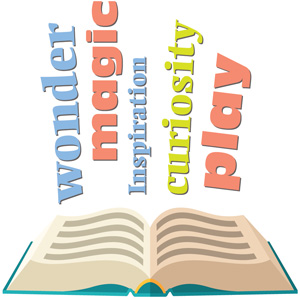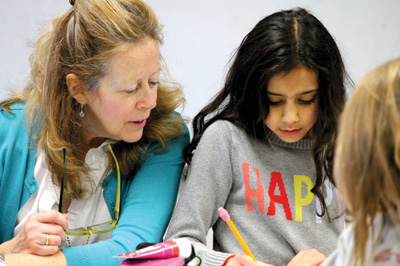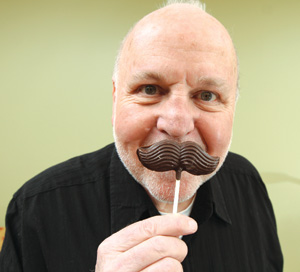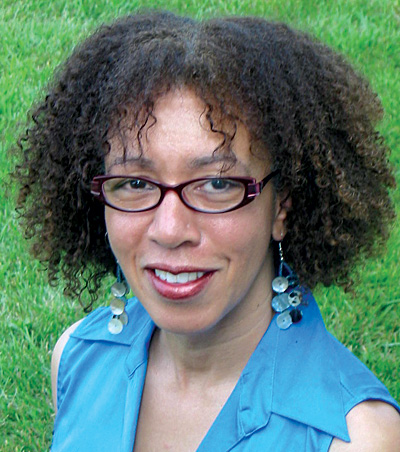Spreading the Word: Poets share their love of language during school visits

.
.
Remember Leo Lionni’s Frederick? That mouse who gathered none of the necessities for winter throughout the summer and fall yet becomes everyone’s hero when the dark and cold set in. What does Frederick offer his peers? His words brighten and warm them and ignite their memories and spirits.
When you invite a poet to visit your school or library, it’s likely that some of those same magical moments will happen. The children will listen differently and hear new sounds; they’ll look differently and see details and colors they’ve missed before; they will feel differently and experience emotions in ways that make everyday moments shine. Their appreciation of words will be heightened. And the pleasure they experience through poetry will be planted firmly inside them to grow throughout their lives.
Rebecca Kai Dotlich, J. Patrick Lewis, and Carole Boston Weatherford reveal how some of the magic happens, what they hope to leave behind, and how much more they take back home with them. Welcome a poet to your library. REBECCA KAI DOTLICH
REBECCA KAI DOTLICH
As a poet going into classrooms and libraries, I begin visits and workshops by nudging students to let their minds and imaginations wander. We talk a lot about curiosity. And I share some things that I wonder about: old ships and shipwrecks, names of butterflies, what kind of childhoods did inventors and scientists have, are astronauts ever afraid, and were they brave when they were small? Then I ask them to think of one thing that they are curious about, wonder about, and I suggest they find nonfiction books and poems about these things. A table covered with poetry anthologies is a great way to jumpstart and layer excitement about all this wondering.
I love to share with them that I collect words:
pudding puddle scribble copper craggy doodle and dandelion
name objects I like to hold and observe: marbles twigs fossils crystals pebbles and pinecones
and throw out topics that I often think about: how did dinosaurs become extinct? what causes the different phases of the moon? are there buried treasures yet to be discovered?
Since I like to create a personal connection, I tell stories of growing up; falling into a construction hole and breaking my arm; slipping into the muddy creek on my way to school; riding bikes on wooded trails; rummaging around an old farmhouse with my brother. Next I give them a look into my writing life by sharing how I get giddy over word journals, maps, charts, compasses, stars sprinkled on a clear night, the tight spiral of a shell, an old coin, a mysterious key.
We begin to play with words and ideas, and a student who usually looks away is looking at me and adding an idea to the conversation and is lost for a moment in a world outside of himself; a world of words and metaphor while we are brainstorming a list of what we might compare an elephant’s ear to: an umbrella, a huge (gray and rumpled) sheet or sail blowing in the wind, a giant leaf or butterfly wing, a lumbering rain cloud.
I can usually tell when students have heard or read a lot of poetry. Dozens of nodding heads and hands waving in the air signal their excitement to share words and images and favorite lines. At times, they help me complete a poem I am reading; they know it by heart! I am amazed, and I tell them so.
Through the years, students have presented me with poems, pictures, stories, and secrets. They’ve given me flowers and crumpled notes. Once, long ago, on a gray, rainy day in New York City, an umbrella. At the heart of every visit is making a connection with those children. We all have stories; we all have a need to be heard, to form friendships, to connect on an intimate level with words and emotions.
Often, when the wind is just right and the rain taps on the roof or the sun pours into the windows, a poet visit is more than rhymes and words and metaphor; it can be that moment when students suddenly see you as a real person, not just a name on the page or the cover of a book. These scheduled but chance meetings are magical moments we both carry through our lives.
![]()
 J. PATRICK LEWIS
J. PATRICK LEWIS
I love to think back on my first school visit, not because it was so excruciatingly painful, which it was, but because it stands in stark counterpoint to the experience of doing a school visit today, which for me is one of pure joy.
I resisted author visits for several years. After all, I was a college professor for 30 years, and that seemed second nature to me. But my friend and collaborator, Paul Janeczko, twisted my arm until I said, “Uncle.” I went on one. As luck would have it, kindergartners were the first class to come.
One of them came right up to me and said, “Did you ever see heaven in third grade?” Right then I was certain I had stepped into the little shop of horrors. But like most kindergartners, as I have since come to learn, he really wasn’t interested in an answer. He just hopped on his spaceship and flew off to Planet Kindergarten. Later, I asked the teacher what he had meant by that question. She said, “Well, there’s a girl in third grade whose name is Heaven, and he wanted to know if you had seen her.”
So, as it turned out, it all made perfectly good sense.
Next, the fourth graders came in, and I thought, well, they are getting bigger. How can that be a bad thing? A girl said to me, “Have you always worn glasses?” I said, “Yes, for a long time.” Then she said, “Have you ever heard of contact lenses?”
Perhaps the most memorable visit occurred a few years ago in Illinois. A fourth grader in 4-H asked me if I owned lambs. I told her no, and she said she had two lambs that had just won blue ribbons at the Champaign (IL) County Fair. When I congratulated her, she became shy and said, “Do you know what their names are?” “No,” I replied. She said, “Patrick and Lewis.” Be still my heart! Then in the next breath, she said, “We had Lewis for dinner last night.”
Amazing things happen at school! If you’re a teacher, I don’t have to tell you that. I was in Hershey, PA, where they make chocolate. A third grader said, “Pat, do you know how to make chocolate milk?” I said no. He said, “You put a Hershey kiss on a cow’s tongue.”
Anyway, in short, I survived. I’ve since made 550 school visits all over the world. And every one of them has been different. People ask me, do you like school visits? I love them! First of all, when kids are well-prepared, they genuinely seem to love poetry. And second, perhaps because of that, they really do treat you like a rock star, so what’s not to like? I know when the day is over I’m going to have to go home and unplug the toilet or perm my hair, or something equally disgusting.
![]()
 CAROLE BOSTON WEATHERFORD
CAROLE BOSTON WEATHERFORD
“Poetry Should Make Music with Words” (after “Poetry Should Ride the Bus” by Ruth Forman) Students should have read the poet’s books beforehand and understand the difference between an author and Arthur, so that she doesn’t have to sketch the famous aardvark and her own face on the board and apologize for not wearing a furry costume. School visits should begin with the poet’s name chalked in big pastel letters on the pavement, gleeful kindergartners greeting her at the front door and fifth graders offering to lug her gear. The halls should be adorned with students’ art— portraits of civil rights leaders, jazz musicians and sports heroes—inspired by the poet’s books. School visits should kick off with hot herbal tea, cinnamon bagels, cream cheese, and red grapes and a cozy chat with the boys book club. Sessions should be in classrooms, libraries multipurpose rooms, or in a pinch, auditoriums; but never in gyms with bleachers and bad acoustics. The room should be decorated with cardboard box robots, rocket ships, and puppet stages straight from the lines of the visiting author’s poems. Primary grades should come first thing in the morning— not at 1 p.m. after just releasing butterflies on the Friday before Easter break. Programs should criss-cross the curriculum with poetry, movement, and music: tambourines, triangles, drums, and a rainstick that zigzags from front row to back, so no child whines, “I didn’t get a turn.” The poet should have students chant her mantra, “Poetry makes music with words,” and then show them why and how. The repertoire should include rhyme and free verse where students chime in on cue as poems chronicle freedom fighters, first ladies, Olympians, presidents, polar explorers, and pioneering artists. The poet should not skip shameful chapters in the American saga such as slavery and segregation and should show slides of documentary images attesting that inhumanities really happened. The poet should use music as a balm: a spiritual, or protest hymn that lets students lift their voices. After back-to-back sessions, the author should relax as students stage a readers’ theater of Birmingham, 1963 or Freedom in Congo Square—complete with songs. The poet should have lunch with 12 lucky students who stare at her as she eats food prepared by the PTA. Each session should conclude with questions— not about her income (trillions), age (49-plus), or favorite color (blue), but about research, writing, publishing, and whether she is returning tomorrow. The poet should touch both the child who struggles with reading and the one who hands her an original poem on notebook paper. The celebration should come to an end with banana splits, sprinkles and smiles, and perhaps an after-school workshop or reception for parents and faculty. Afterwards, students should send the poet thank-you notes gushing about how much fun they had with the poems and percussion and admitting that they expected to be bored but are now her biggest fans.
RELATED
The job outlook in 2030: Librarians will be in demand
The job outlook in 2030: Librarians will be in demand
ALREADY A SUBSCRIBER? LOG IN
We are currently offering this content for free. Sign up now to activate your personal profile, where you can save articles for future viewing






Add Comment :-
Comment Policy:
Comment should not be empty !!!
Charles Waters
Thank you SO much for this article. As a children's poet who does school visits, I'm always looking for masters of the poetic trade to share their experiences. This was glorious. :-)Posted : Jun 09, 2016 01:49